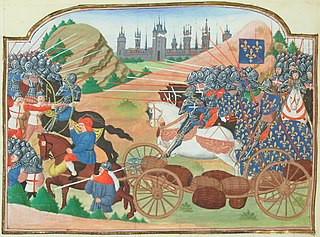 W
WThe Battle of Beaugency took place on 16 and 17 June 1429. It was one of Joan of Arc's battles. Shortly after relieving the siege at Orléans, French forces recaptured the neighboring district along the Loire river. This campaign was the first sustained French offensive in a generation during the Hundred Years' War.
 W
WThe Battle of Jargeau took place on 11–12 June 1429. It was part of the Loire Campaign during the Hundred Years' War, where Charles VII's forces successfully recaptured much of the region following their victory at the siege of Orleans. The battle ended in victory for Charles VII and is notable as Joan of Arc's first offensive battle.
 W
WThe Battle of Meung-sur-Loire took place on 15 June 1429. It was one of Joan of Arc's battles following relief of the siege at Orléans. This campaign was the second sustained French offensive in a generation in the Hundred Years' War.
 W
WThe Battle of the Herrings, also called the Battle of Rouvray, was a military action near the town of Rouvray in France, just north of Orléans, which took place on 12 February 1429 during the siege of Orléans in the Hundred Years' War. The immediate cause of the battle was an attempt by French and Scottish forces, led by Charles of Bourbon and Sir John Stewart of Darnley, to intercept a supply convoy headed for the English army at Orléans. The English had been laying siege to the city since the previous October. This supply convoy was escorted by an English force under Sir John Fastolf and had been outfitted in Paris, whence it had departed some time earlier. The battle was decisively won by the English.
 W
WThe Forcible Entry Act 1429 was an Act of the Parliament of the Kingdom of England. It is written in the Anglo-Norman language. It was expressed to be passed because the statute 15 Ric 2 c 2 was felt to be inadequate because it did not apply to persons committing forcible detainer after a peaceful entry or to persons who, having committed forcible detainer, had been expelled from the land before the justice of the peace arrived to arrest them, and because it did not provide for the punishment of a sheriff who failed to carry out the orders of the justice of the peace to execute the statute.
 W
WThe Loire Campaign was a campaign launched by Joan of Arc during the Hundred Years' War. The Loire was cleared of all English and Burgundian troops.
 W
WThe Battle of Patay was the culminating engagement of the Loire Campaign of the Hundred Years' War between the French and English in north-central France. The French cavalry inflicted a severe defeat on the English. Many of the English knights and men-at-arms on horses were able to escape but crippling losses were inflicted on the corps of veteran English longbowmen, which was not reconstituted after the battle. This victory was to the French what Agincourt was to the English. Although credited to Joan of Arc, most of the fighting was done by the vanguard of the French army as English units fled, and the main portions of the French army were unable to catch up to the vanguard as it continued to pursue the English for several miles.
 W
WThe Siege of Orléans was the watershed of the Hundred Years' War between France and England. It was the French royal army's first major military victory to follow the crushing defeat at the Battle of Agincourt in 1415, and also the first while Joan of Arc was with the army. The siege took place at the pinnacle of English power during the later stages of the war. The city held strategic and symbolic significance to both sides of the conflict. The consensus among contemporaries was that the English regent, John of Lancaster, would have succeeded in realizing his brother the English king Henry V's dream of conquering all of France if Orléans fell. For half a year the English and their French allies appeared to be winning but the siege collapsed nine days after Joan's arrival.
 W
WThe siege of Paris was an assault undertaken in September 1429 during the Hundred Years' War by the troops of the recently crowned King Charles VII of France, with the notable presence of Joan of Arc, to take the city held by the English and the Burgundians. King Charles's French troops failed to enter Paris, defended by the governor Jean de Villiers de L'Isle-Adam and the provost Simon Morhier, with the support of much of the city's population.